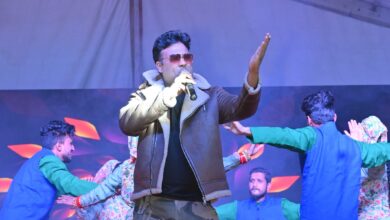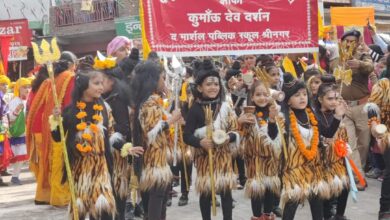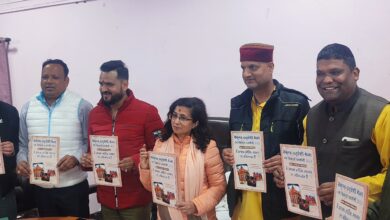Tribal Navratri Tradition

Goddess worship is considered as the main in Indian culture, but in tribal culture, worship of nature is considered main. There is no doubt that tribal society and culture originated from India in the world. In tribal culture, Adi Dev Phada Pen and Lord Shiva are one, Of course, it is Advaita. We have the same origin, Therefore, the ill-fated attempt to divide us by disruptive and harmful forces will never be successful.
There has been a very ancient, vast, rich and respectable tradition of worship of nature, worship of Shakti, worship of women in India. It includes rural and urban, forest dwellers and townspeople, tribal and non-tribal. If you look closely, all these living habits, customs, civilization-culture, thoughts and beliefs all seem the same, seem to match each other. Shakti i.e. Goddess worship is also one such tradition, whose location is visible everywhere in India. Celebrations related to this The festival of Shardiya Navratri is also such a festival, which is celebrated with great pomp in all the rural, urban, forest dwelling areas, which proves that we Indians, who are called Hindus, are one. Vanvasi tribal society has always been an integral part of Sanatan Hindu Dharma.
Even though, due to the development of civilizations and continuous foreign and cultural invasions, there is a partial difference in the relocation of tribal society and traditions, culture, marriage, customs, method of worship, dialect and work style, but in the present perspective, the tribal of Sanatan Hindu society The core and center of both the non-tribal and non-tribal units is the axis of Hindutva. Our habitats, living habits have become a bit isolated due to their long separation, yet internally all are integrated. Seeing which all the divisive conspiracies to define the tribal forest dweller society apart from the majority Hindu religion of India seem to collapse. Even today in the village – village is rural i.e. Village Devi, Vanadevi, Devi Mandap, Bagh Devi, Jwala Mai, Sati Devi, Dhumavati, Maladevi, Khermai Mata, Tongri Devi, Dungri Mata, Sarna Devi Temple, Mandap, Pat, Madhiya and many others. There are symbol sites related to the goddess.
The cities are full of goddess temples and deity places, in which huge crowds of people of all classes gather to pay their respects to nature, power worshippers. And at the places of pilgrimage, it is not possible to describe their glory even with a thousand-faced Sheshnag. On the occasions of Navratri, their beauty is made on sight. During Navratri, different branches of the entire Sanatan Samaj worship Adishakti in different ways and wish them happiness, peace and prosperity. The festival of Shardiya Navratri is celebrated in the form of Durgotsav in all the forest, rural and urban areas.
Celebrated for nine days, all nine forms of Mother Durga are worshiped in this puja. Nevertheless, Navratri worship of forest dwellers is slightly different from rural and urban areas. There is variety in their names and worship method. The forest dwellers pray to the Goddess for happiness, prosperity, good harvest, rain and protection of nature. This is the reason that tribal society is considered as the carrier of Sanatan culture. In the tribal society, the practice of worshiping, worshiping, worshiping and celebrating festivals with gaiety has been going on since time immemorial. Even today, on the festival of Navratri, rituals are performed by the tribal society at various deity places and special worship is done.
At the time of Navratri festival, where Adi Shakti is worshiped with gaiety throughout the country, on the other hand, in the tribal areas also, the tribal society worships the mother with full devotion and devotion. The spirit of tribal culture resides in the villages, in the forests. Where even today tribal societies worship Mother Bhagwati by incorporating the unity of Hindu culture. The worship method may be different, but many such temples exist in villages, cities and surroundings, where tribes come to worship continuously for hundreds of years. Oraon, Munda, Khadia, Santhali, Pahariya etc., like majority of Hindus, because of residing in rural, town and urban areas, go to Devi Mandaps, Devi Mandirs and Puja pandals and worship different forms of Navdurga. This can be easily guessed from the crowd of women of the tribal community who throng these goddess places on the occasions of Vasantiya and Shardiya Navratri.
Navani worship in Bhil society, Khero Mata in Gond society, worship of Goddess Mai, worship with Dasanya dance in Jharkhand, Dungri Mata in Kattiwada region of Madhya Pradesh, Ashtami worship in Jaunsar-Bawar in Gujarat, Jiya in eastern Uttar Pradesh, Bihar and Jharkhand (Jawa) Worship, in the Gumla district, in the Sribara Durga temple, Korku society worships the Mother Goddess in the form of Dev-Dussehra. In the Bhil society, the Bhils worship their Kuldevi and Durga-Bhavani in Navani festival. This festival starts from the Padwa of Shukla Paksha in the month of Ashwin i.e. Kwar. On this occasion, all the Gods and Goddesses apologize for the mistakes done throughout the year. People of the tribal society of Jharkhand worship Mother Adishakti in some unique way. In the tribal society, the goddess is worshiped through the Dasai (Dasanya) dance. Here in the tradition of the local tribal society, the worship of the Goddess starts from the day of Mahashashthi of Navratri.
According to the tribal tradition, on the day of water filling, people of the tribal community take bath and reach Jaherthan in the village. During this, Adishakti is worshiped with full rituals. After the worship of the tribal musical instrument, Dasanya dance begins at Jahersthan. After leaving this place, people of tribal society go from house to house and burn incense till before Maha Dashami. This festival is incomplete without tribal dance and music. In Jaunsar-Bawar, Gujarat, in Navratri, out of the nine forms of Goddess Durga, only Ashtami i.e. Mahagauri is worshipped. In every family, the head of the household observes a fast on the Ashtami of Navratri, during the day the mother is worshiped with pudding, and in the evening there is no abstinence from non-vegetarian food. Different states of the country have their own different way of celebrating Navratri festival.
Dandiya and Garba are celebrated during Navratri in Gujarat. Durga Puja is main in West Bengal. Similarly, nine forms of Navratri are duly worshiped in every state. Mother Shailputri, the daughter of mountains in the whole country, Brahmacharini, the mother of special grace, Chandraghanta, who shines like the moon, Kushmanda, the mother of Kartik Swami, Skandamata, the mother of Kartik Swami, Katyayani born in the Katyayan ashram, Kalratri, the destroyer of time. Worship is offered to Mahagauri, the white divine radiance, the mother Siddhidatri, who bestows all accomplishments.
It is noteworthy that in the tribal society of India, Bada Dev has been considered as the original, he is in the form of Shiva in Indian culture. But both are following Sanatan Dharma only. There is a similarity between tribal and non-tribal culture. Goddess worship is considered important in Indian culture, but in tribal culture, worship of nature is considered main. There is no doubt that tribal society and culture originated from India in the world. In tribal culture, Adi Dev Phada Pen and Lord Shiva are one and the same, that is, Advaita. Our origin is the same, so the malicious attempt to divide us by disruptive and harmful forces will never succeed. Their attempt to create discrimination by western scholars and so-called seculars by telling the prohibition of idol worship in tribal society is nothing but foolishness.




